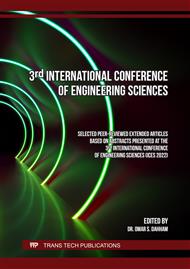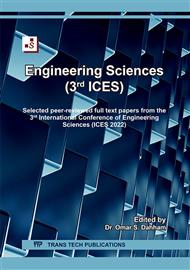[1]
Khillar, S. (2021, April 9). Difference Between Beam and Girder. Difference Between Similar Terms and Objects. http://www.differencebetween.net/object/difference-between-beam-and-girder/.
Google Scholar
[2]
Rahimi, H. and Hutchinson, A. (2001), "Concrete beams strengthened with externally bonded FRP plates", Journal of Composites for Construction, vol. 5, no. 1, pp.44-56.
DOI: 10.1061/(asce)1090-0268(2001)5:1(44)
Google Scholar
[3]
Pham, H. and Al-Mahaidi, R. (2004), "Experimental investigation into flexural retrofitting of reinforced concrete bridge beams using FRP composites", Composite Structures, vol. 66, no. 1, pp.617-625.
DOI: 10.1016/j.compstruct.2004.05.010
Google Scholar
[4]
Gao, B., Leung, C. and Kim, J. (2005), "Prediction of concrete cover separation failure for RC beams strengthened with CFRP strips", Engineering Structures, vol. 27, no. 2, pp.177-189.
DOI: 10.1016/j.engstruct.2004.09.007
Google Scholar
[5]
Wu, Z. and Niu, H. (2007), "Prediction of crack-induced debonding failure in r/c structures flexurally strengthened with externally bonded frp composites", Doboku Gakkai Ronbunshuu E, vol. 63, no. 4, pp.620-639.
DOI: 10.2208/jsceje.63.620
Google Scholar
[6]
Yao, J. and Teng, J. (2007), "Plate end debonding in FRP-plated RC beams—I: Experiments", Engineering Structures, vol. 29, no. 10, pp.2457-2471.
DOI: 10.1016/j.engstruct.2006.11.022
Google Scholar
[7]
Alfano, G., De Cicco, F. and Prota, A. (2012), "Intermediate debonding failure of RC beams retrofitted in flexure with FRP: Experimental results versus prediction of codes of practice", Journal of Composites for Construction, vol. 16, no. 2, pp.185-195.
DOI: 10.1061/(asce)cc.1943-5614.0000250
Google Scholar
[8]
Fu, B., Chen, G. and Teng, J. (2017), "Mitigation of intermediate crack debonding in FRP-plated RC beams using FRP U-jackets", Composite Structures, vol. 176, pp.883-897.
DOI: 10.1016/j.compstruct.2017.05.049
Google Scholar
[9]
Mohammadi, T., Wan, B., Harries, K. and Sweriduk, M. (2017), "Bond Behavior of FRP–Concrete in Presence of Intermediate Crack Debonding Failure", Journal of Composites for Construction, vol. 21, no. 5, p.04017018.
DOI: 10.1061/(asce)cc.1943-5614.0000797
Google Scholar
[10]
Aiello, M., Galati, N. and Tegola, A., (2001) "Bond analysis of curved structural concrete elements strengthened using FRP materials", FRPRCS-5: Fibre-reinforced plastics for reinforced concrete structures Vol. 1, pp.399-408.
DOI: 10.1680/frprcsv1.30299
Google Scholar
[11]
D. Porter., A, Denton., S, Nanni., A and Tim, I. (2003), "Effectiveness of FRP plate strengthening on curved soffits", FRPRC-6.
DOI: 10.1142/9789812704863_0110
Google Scholar
[12]
Eshwar, N., Ibell, T. and Nanni, A. (2005), "Effectiveness of CFRP strengthening on curved soffit RC beams", Advances in Structural Engineering, vol. 8, no. 1, pp.55-68.
DOI: 10.1260/1369433053749607
Google Scholar
[13]
Al-Ghrery, K., Kalfat, R., Oukaili, N., Al-Mosawe, A. & Al-Mahaidi, R. (2019) "Strengthening of Concrete Bridge Girders with Concavely-Curved Soffit Using Fiber Reinforced Polymer", Bridge Engineering Institute, pp.502-509.
DOI: 10.1201/9780429279119-196
Google Scholar
[14]
ACI Committee 209, (1992), "Guide for Modelling and Calculating Shrinkage and Creep in Hardened Concrete",American Concrete Institute, Detroit.
Google Scholar
[15]
Qusay Wahhab Ahmed, " Behavior Of Composite Steel-Concrete Beams With External Prestressing, 2011.
Google Scholar
[16]
A. Kaw, Ed., "Mechanical of Composite Materials", CRC Press LLC, Boca Raton, Florida, USA,1997.
Google Scholar
[17]
Seracino (ed), "FRP Composites in Civil Engineering – CICE 2004", Taylor & Francis Group,London, p.556, 2004.
DOI: 10.1201/9780203970850
Google Scholar



